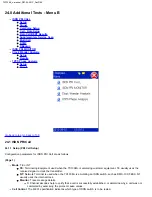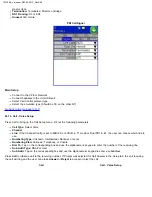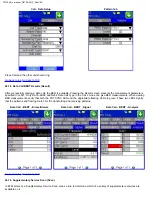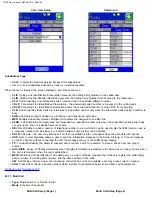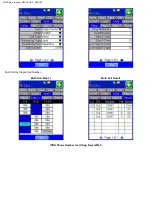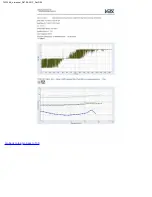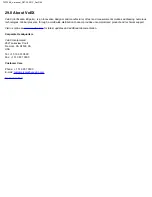
Please consult the factory.
24.4 Reference Clock Wander Analysis
This advanced synchronization tool allows users to compare different types of Reference Clock sources and measure phase
differences (TIE) to establish accuracy and stability. It is a generic wander measurements analysis option that provides a flexible
function that allows testing different types of reference clocks against other reference clocks, including test rates (G.703), analog
(sinosoidal), and digital (TTL) signals. This function is independent of the test mode selected in the unit.
Test Signals:
- 1.544 MHz, 2.048 MHz, 1.544 Mbit/s, 2.048 Mbit/s, and 1PPS*
- Balanced (100 Ohm bantam or 120 Ohms RJ48) or Unbalanced (75 Ohm BNC)
* See 1PPS vs. 1PPS Analysis
Reference Clocks:
- 1.544 MHz, 2.048 MHz, 10 MHz, 25 MHz, 125 MHz, 1.544 Mbit/s, 2.048 Mbit/s, 1PPS
To access the Reference Clock Wander Analysis feature, press the Mode button to get to PDH, select Additional Tests (Add.
Tests), and tap on Clock Wander Analysis.
24.4.1 Setup
Test Signal:
Select the appropriate signal type to match the signal under test
T. Signal Port:
Select the appropriate test port type to match the balanced or unbalanced and impedance characteristics of the
signal under test.
Ref. Clk. Port:
Select the appropriate connector or port required to match reference clock interface. Available options depend on
test port configuration and rate. Converter cables may be required in certain cases.
Reference Clock:
Select the type of signal that matches reference clock signal to be used.
Mode:
Manual or Timed. In Manual, the user starts and stops the measurement manually. In Timed mode, users enter a specific
test duration and the test will stop once the set time has elapsed. Duration can se entered in seconds, minutes, hours or days
(up to 60 days)
Save TIE to USB:
OFF presents the current real time TIE measurements on screen only. ON sends real time TIE
measurements to an attached USB memory, for further post analysis (refer to the MTIE and TDEV Analysis section). This feature
requires the MTIE and TDEV Post Analysis option.
Sampling Rate:
When Save TIE to USB is ON, this selection indicates how many samples per second are recorded and stored
in the USB memory stick.
File name:
If Save TIE to USB is set to ON, the test set asks for a file name.
Press the Start button to run the test. The test starts immediately. Do not remove the USB memory stick while the wander test is
_e-manual_D07-00-051P_RevD00
Summary of Contents for VePal TX130M+
Page 1: ...TX130M _e manual_D07 00 051P_RevD00...
Page 19: ...Go back to top Go back to ToC TX130M _e manual_D07 00 051P_RevD00...
Page 69: ...Go back to top Go back to ToC TX130M _e manual_D07 00 051P_RevD00...
Page 105: ...Go back to top Go back to ToC TX130M _e manual_D07 00 051P_RevD00...
Page 171: ...Go back to top Go back to ToC TX130M _e manual_D07 00 051P_RevD00...






